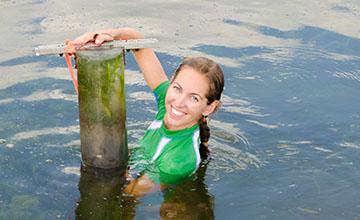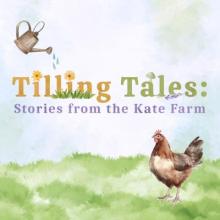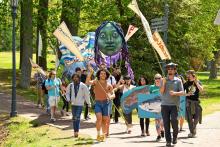
Cassie Gurbisz, assistant professor of environmental studies, has received a grant for $19,073 from the Ferry Cove Project, a non-profit organization dedicated to expanding the Chesapeake Bay oyster aquaculture industry. Partnering with Dr. Jeremy Testa from University of Maryland Center for Environmental Science Chesapeake Biological Laboratory, Gurbisz will collect measurements in the waterways around Tilghman Island, Maryland, to quantify the effects of a new oyster hatchery on the local coastal environment.
The hatchery, to be located on an 80-acre farm with several hundred feet of shoreline, will include a floating oyster conditioning area and a 400-foot oyster reef breakwater. Measurements in and around the conditioning area, which includes floating oyster cages to be installed atop beds of submersed aquatic vegetation (SAV), provide an excellent opportunity to investigate the ways in which oyster aquaculture interacts with SAV. This has recently become a hot topic as both SAV abundance and aquaculture leases expand and therefore compete for space in shallow regions of the Chesapeake Bay. Data collected prior to and after the construction of the oyster breakwater and the adjacent marsh will generate information about the ways in which this increasingly popular but understudied shoreline defense structure modifies physical and ecological processes at the land-water interface. While each of these objectives is valuable individually, together they will constitute a unique case study of how the coastal environment responds to multiple human uses from a holistic, integrated perspective.
The goal of the current project is to collect baseline environmental data before hatchery construction begins. Over the next several years, Gurbisz and Testa hope to continue the project to collect post-construction data and make more detailed measurements. This project complements Gurbisz and Testa’s ongoing work funded by Maryland Sea Grant to study the effects of bottom cage oyster aquaculture on SAV. Ultimately, their goal is to provide scientifically sound information to guide regional environmental policy and management decisions related to SAV-oyster aquaculture interactions.



